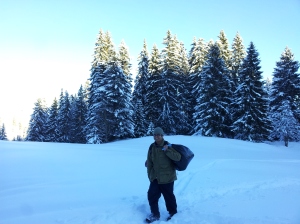Five-day best of Nakasendo Trail itinerary
November 18, 2018

Apart from the usual Magome-Tsumago route I found little info on how to enjoy a longer experience of the Nakasendo Trail. I managed to glean a few details from tour operators offering expensive self-guided trips but only when I was on the trail was I able to connect the dots. I hope this is handy for travellers looking to explore the best bits of the trail on their own. This is a tried and tested itinerary. I travelled in October 2018.
Tokyo – Magome – Tsumago – Kiso Fukushima – Narai
Tokyo to Magome
I decided to take a bus instead of train from Tokyo to Magome, the first of the “Post towns” on my route. The bus was a much cheaper and simpler option. Otherwise I would need to change trains a few times and catch a local bus to get to Magome. I asked my Tokyo hotel to forward my luggage to my Kyoto hotel so that I could travel light on my Nakasendo adventure. A great service offered by almost all Japanese hotels. I paid around $15 for a large suitcase.
I caught the bus at the Shinjuku bus station (you can also embark at Tokyo main bus station) at 10:40 am and reached Chuodo Magome at 15:22. The distance covered was 288 km and it was one of the most pleasant coach rides I ever had.
From the bus stop you need to cross the road via an overhead bridge. It is around a 1.7 km walk to Magome village. My Nakasendo adventure had begun!
The tourist coaches had left and I had the village to myself. I checked in to the Magome Chaya Minshuku or guest house. It was the only place I could book online. It had a bit of a backpacker hostel feel with no Japanese guests in sight. My room was clean though and the food was really good.
Magome village has several shops selling souvenirs as well as snacks for hungry travellers. Its elevation offers some nice views of the countryside.
Magome to Tsumago
This is the most popular section of the Nakasendo Trail. After a hearty breakfast we set out to walk the 6 km to Tsumago. The trail is well marked. I took the signs warning of the presence of bears and the bells to scare them off with a pinch of salt.
A nice pit stop on the way is tea house overseen by an elderly man. The tea is free in return for filling a questionnaire about your visit. The tea house has featured in many travel documentaries.
I reached Tsumago in the early afternoon. It is a lovely village with more shops than Magome. Lots of things to see and buy.
I stayed at the Maruya guest house located a kilometre or so from the village. The only other guests were a Japanese family who were staying in a completely separate wing. My stay was more peaceful and the room was about twice the size as the one I had in Magome. Highly recommend the place even if I somehow forgot to take pictures.
Tsumago to Kiso Fukushima via Nojiri
This was the longest leg of my trip: around 19 km. Most travel logs recommend walking 3 km from Tsumago village to the Nagiso railway station and take a train to Kiso Fukushima. I wanted more and was intrigued by the idea of a six hour walk mentioned by some tour operators through bamboo forests and over the Nenoue-Toge pass. There was one problem: the tour operators did not share details of the route for obvious reasons. A map from the tourism office showed that I would need to bypass a shrine and the Nagiso railway station and head to higher ground.
I avoided the road going down to the station and headed up a mountain road instead. It didn’t feel right as it was a large road for vehicles. With misgivings, I kept going keeping my fingers crossed for a Nakasendo Trail sign. To my great relief, I finally came across the first sign. It lifted my spirits to finally know I was on the right path.

The path was mostly on a road for a few kilometres, passing houses.
After half-an-hour of walking uphill, houses gave way to fields and open country. A diversion from the road took me through forest paths and roads. Typhoon Trami had left its mark, with fallen trees a common sight.
I eventually crossed the Nenoue-Toge pass, and the terrain became less steep.
While I didn’t see any bears I did come across some wildlife.
I reached the enchanting-looking bamboo forest path that was advertised by the tour operators.

Towards the end, I came to a large road with pine forest all around. It was the least picturesque part of this stage and we had to rush a little bit as wanted to catch our train from Nojiri to Kiso Fukushima. There are very few trains going that direction (around one every two or three hours).
Around six hours after I had set out from Tsumago, I finally reached Nojiri. The town is not spectacular and I was too tired to explore anyway. I raided the vending machines at the train station for refreshments. Worth noting that I saw no shops selling food on this route. I had set aside some power bars for fuel.
 The ticket counter at the station was closed. You can buy your ticket from the train driver (yes the train driver) when the train arrives at your destination. Or if he is in a rush, you can also buy it while exiting the station.
The ticket counter at the station was closed. You can buy your ticket from the train driver (yes the train driver) when the train arrives at your destination. Or if he is in a rush, you can also buy it while exiting the station.
Kiso Fukushima is not as pretty as other post towns. It is larger and more urban. It does offer decent shopping though. I stayed at the Kiso Mikawaya which was more a hotel than a guest house. While it lacked in charm, it had large rooms with an attached toilet (most guest houses have shared toilets and showers). The hotel also had an onsen (hot bath) big enough for 20 people. The other guest houses or Minshukus only had single-person onsens. The icing on the cake were the massage chairs for guests in the laundry room.
Kiso Fukushima was also the place where travellers obtained authorization to continue along the Nakasendo Way. I visited a museum that documents the role of the town as an important controlling station. I got to role play as an official that was responsible for stamping the travel papers of voyagers.

Kiso Fukushima to Narai via Yabuhara
To get to a nice section of the Nakasendo trail I had to catch a train from Kiso Fukushima to Yabuhara. I approached the ticket counter to buy my train ticket but was told it was not possible. The ticket vendor didn’t speak English so he connected me to a remote assistant via a tablet. She explained that the train was not running and they had no idea when the next to train to Yabuhara would arrive. Rather than waste time waiting at the station I took a taxi to Yabuhara which cost around $30. The driver couldn’t believe I was going to cross the Tori pass on foot.
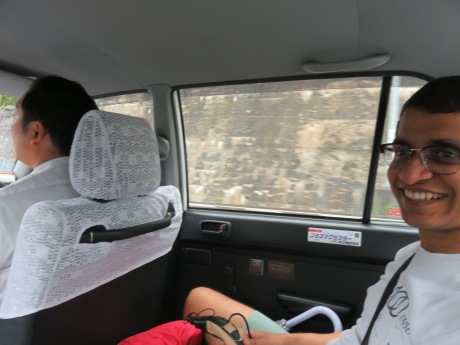
The trail was well signposted at the Yabuhara station and I soon found myself in a forest.
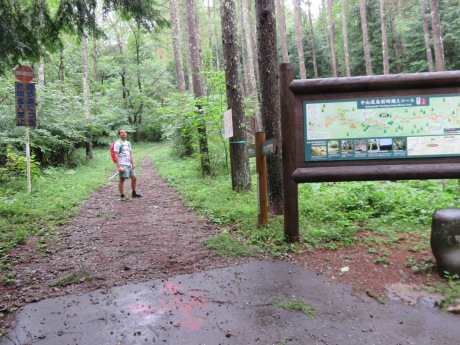
After sweating buckets in the humidity, I reached the Torii gate and shrine.
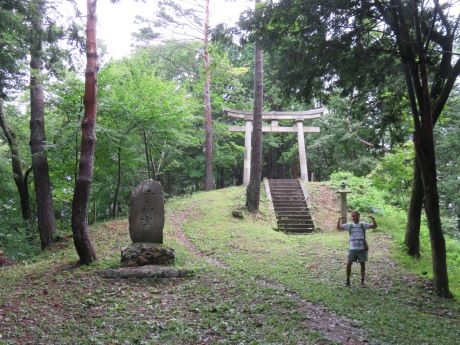
It was almost all the way downhill from there. The hills were lush and the trail was perfect for brisk walking. Only power lines marred the view.
The path suddenly ended on the outskirts of Narai village. It took me 1.5 hours to cover the 6 km. It was over too soon.
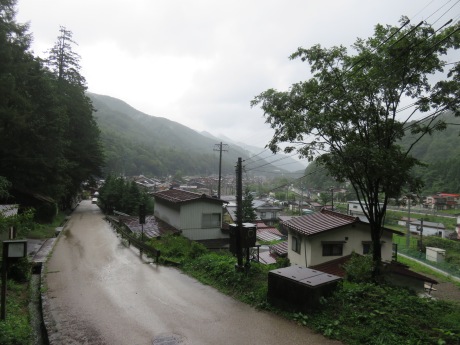
Narai was quite pretty. It seemed like a lot of effort had been made to restore and preserve the buildings.
The tourism office was keen to show off its robot but it was not cooperating. The lady apologized profusely of course.

I had some time to kill before I could check into my Minshuku. So I decided to have a coffee at an interesting café which had two poodles Chopin and Piano milling around.
I stayed at the Iseya guest house and was given a room in the annexe overlooking the garden. Nice place even if it was the most expensive Minshuku of my trip.
My Nakasendo adventure had come to an end. I left next morning for Kyoto but not before checking out the only concrete building in town.

Five things I learnt from my Man vs Wild experience
March 22, 2014
I spent a night in the Jura mountains of Switzerland trying to understand what it takes to survive in sub-zero conditions. I built my own shelter from what was available around me. Here is what I learnt:
- Don’t count on building a fire. Sure, a fire is real comfort against cold but what if you can’t build one? Everything around me was covered in a metre of snow. Finding kindling and wood was practically impossible. Besides, starting a fire in freezing conditions can be a real pain in the ass.
- Invest time in constructing a good shelter. Your shelter is your mothership in a hostile environment. Spend a few hours in making it as insulated as possible with what is available. Snow, branches, leaves, and soil create air pockets that keeps the shelter warm. It should be as small as possible to prevent losing heat through radiation. You should just be able to squeeze into it without touching any portion of it (to prevent conduction heat loss). I used and recommend this survival shelter for cold conditions.
- Stay dry. Before you settle into your shelter, make sure all your clothing is dry. It is really easy to lose heat through a single item of wet clothing. My slightly wet trousers kept me from be being fully comfortable and negated a lot of the other preparation I had made.
- Don’t fly solo. Things can go horribly wrong real fast. Have someone near you in case this happens. I had left my wet shoes outside my shelter and couldn’t get into them in the morning as they had frozen solid. Luckily, my friends were camping a few hundred metres away. I walked to their camp in my socks and cooked my shoes on their fire before I could wear them. No toes lost due to frostbite.
- Carry a shovel. I didn’t and quickly realized how badly I needed one. I am not keen on camping gear as I feel it detracts from an authentic wild experience. But I will always make an exception for a portable shovel. I borrowed one from my friend and it saved me. I used it to clear the ground for my shelter from snow and ice. I also used it to pile snow on my shelter for insulation. Without it I would be doing these tasks with my bare hands or a stick. It is a real must-have.
Whatever you do, try camping outdoors with your own shelter. You quickly learn what works under a given set of conditions. No YouTube video or survival manual can replace first-hand experience.
Pictures and adventure courtesy: Vincent Kurmaer
Think.Eat.Save is the theme for this years World Environment Day celebrations. The aim is to bring attention to the problem of food waste and the impact our ‘food-print’ is having on the environment. The wastage of food from farm to fork is also a reflection of the imbalance in lifestyles between the “haves” and “have nots”. While 1.3 billion tonnes of food waste is generated every year, one in seven people go to bed hungry and more than 20,000 children under the age of five perish every day from hunger. This proportion of the world’s population often has to rely on the natural resources in their vicinity to meet basic nutritional needs. They are also most vulnerable to the impacts of the degradation of ecosystems that provide these natural resources.
Full article on TEEB for Water and Wetlands
Building a fairer world, one concrete brick at a time
March 18, 2013
 Fairness has always been one of the aspirations of an ideal society. From the school playground to the International Court of Justice, fairness forms the basis of peaceful coexistence. Equality before law, one person one vote, empowerment of women, affirmative action, and the welfare state are attempts at realizing the principle of fairness and building a more equitable society. Environment protection is no exception. The ‘polluter pays’ principle forms the backbone of most multilateral environment agreements, most notably the United Nations Framework Convention on Climate Change (UNFCCC). Under this convention, developed countries responsible for the bulk of greenhouse gas emissions from 200 years of industrialization have to commit to reducing their emissions drastically. Developing countries can industrialize without binding restrictions for the moment. But for how long? Until they reach a sufficient level of economic development? Until the CO2 in the atmosphere reaches 400ppm? Until the consequences of climate change outweigh the benefits of fossil fuel based industrialization?
Fairness has always been one of the aspirations of an ideal society. From the school playground to the International Court of Justice, fairness forms the basis of peaceful coexistence. Equality before law, one person one vote, empowerment of women, affirmative action, and the welfare state are attempts at realizing the principle of fairness and building a more equitable society. Environment protection is no exception. The ‘polluter pays’ principle forms the backbone of most multilateral environment agreements, most notably the United Nations Framework Convention on Climate Change (UNFCCC). Under this convention, developed countries responsible for the bulk of greenhouse gas emissions from 200 years of industrialization have to commit to reducing their emissions drastically. Developing countries can industrialize without binding restrictions for the moment. But for how long? Until they reach a sufficient level of economic development? Until the CO2 in the atmosphere reaches 400ppm? Until the consequences of climate change outweigh the benefits of fossil fuel based industrialization?
Developing countries are prepared in theory to accept binding commitments but with a tricky caveat – the commitments should be based on the principle of social justice and not put a massive handbrake on their economic development. Sure, green energy and the carbon market were designed to achieve these goals but it will take several decades and a total overhaul of the standard development pathway for them to have any effect. Developing countries like China and India that are riding on the crest of a quick & dirty economic boom cannot afford to wait for the promised shipment of green tech to arrive. This is at the very heart of the reluctance of developing countries to accept binding greenhouse gas emission reduction commitments. Is there a way to successfully juggle climate change mitigation, rapid economic development and climate justice?
One solution is concrete. Not as glamorous as gleaming wind turbines or shiny electric cars, this ubiquitous construction material has a lot to offer for little investment. For starters it is the most widely used material on the planet. Currently cement production is responsible for 5-8% of all global man-made emissions. Hence even though the cement industry is notorious for greenhouse gas emissions, there is a lot of potential due to the sheer scale of the stuff we use. To put this in perspective, even a modest 10% reduction in emissions in producing a cubic metre of concrete would result in savings equivalent to the total CO2 emissions produced by the entire steel industry. Demand for concrete is expected to double or even treble by 2050. And guess where concrete demand is coming from?
Emission reductions in concrete manufacture can be achieved in two ways – 1) increasing the energy efficiency of cement plants or 2) partially substituting cement with less energy-intensive materials. The first option has pretty much been optimised with the energy efficiency in the best cement plants touching 80%. The second option has more potential. Fly ash, a waste product from burning coal can replace up to 30% of the cement in concrete production. However, there is nowhere near enough fly ash in developing countries to match the demand for cement. Thus the answer lies in finding a locally abundant cement substitute. This will also go some way in addressing the emissions resulting from transporting raw material, cement and clinker around the world.
A potential candidate is clay. Clay is definitely an abundant raw material and studies have shown that calcined clay (clay that undergoes a thermal treatment process) can replace between 30-60% of cement in concrete without compromising its durability. However, more research is needed to accurately predict the behaviour & interactions of calcined clays in concrete and their long-term performance over the lifespan of a concrete building. That is small price to pay for a key piece in the greenhouse gas emissions reduction puzzle.
References
Technology Roadmap: Low-Carbon Technology for the Indian Cement Industry
The Laboratory of Construction Materials, EPFL
Nanocem: The Industrial-Academic Research Network on Cement and Concrete
Scientific paper as a poem
January 28, 2013
Gramicidin S Interrogation

gramicidin S was not like his fellow gramicidins
There was nothing linear about him
Two identical pentapeptides joined head to tail
Synthesized by gramicidin S synthetase
He was recruited for antibiotic duty in 1942
Fighting against bacteria and some fungi too
His fighting technique was well known in vivo
Binding with phospholipids of cell membranes was the way to go
In silico GS was more of a mystery man
Perhaps his intrinsic and native structure could reveal his plan
Know your enemy is what Machiavelli and Sun Tzu say
Maybe GS will reveal all with molecular H-bonding interplay
A good place to start is gas phase isolation
Progressive water(molecule)boarding helps control interaction
Add a bit of cryogenic cooling to avoid thermal congestion
A unique spectroscopic fingerprint is the final destination
GS he seemed like such a tough guy
But it took only 2 water molecules to make him cry
The complex stereoscopic fingerprint of GS was cracked
With these constraints it should be easy for the theorists to attack.
REFERENCES
Nagornova NS, Rizzo TR and Boyarkin OV (2012) Interplay of Intra- and Intermolecular H-Bonding in a Progressively Solvated Macrocyclic Peptide . Science 336, 320; DOI: 10.1126/science.1218709
Image credit: Wikipedia Commons
Science will soon speak one language (fiction)
January 28, 2013
A fictional article I wrote for the Swiss Federal University Lausanne (EPFL).
EPFL will join forces with the search-engine giant Google as well as other scientific partners to develop a translation tool for scientific literature. EPFL’s Probabilistic Machine Learning Lab will be a part of a global initiative called linguaSCIENCE that aims at offering scientists the ability to translate scientific papers in English into their native language and vice-versa. This tool aims to overcome the language barrier often faced by scientists from non-English speaking countries, and thus promote global scientific collaboration.
Collaboration lost in translation?
Science has always been about collaboration. The globalisation of science has resulted in scientists from all over the world working with each other to add to the body of science. It is now almost the norm to have scientific papers with multiple authors of diverse nationalities. However, the extent of this collaboration could be overestimated.
In the spirit of the well-circulated Facebook friendship map by Paul Butler, research analyst Olivier Beauchesne at Science-Metrix examined scientific collaboration around the world from 2005 to 2009 by extracting and aggregating scientific collaboration between cities all over the world (see fig.). Looking at the map there doesn’t seem to be much collaboration outside of the United States and Europe. Beauchesne is unsure if that’s because of a limited dataset or really because there’s little collaboration in those areas. Could language be one of the contributing factors?
Machine learning to the rescue
If so, “statistical machine learning” (SML) could help prevent science from being lost in translation. SML is the process of seeking patterns in large amounts of text. It has already helped Google carve a niche for itself in translation with Google Translate, a free translation service that provides instant translations between 64 different languages.
When Google Translate generates a translation, it looks for patterns in hundreds of millions of documents to help decide on the best translation. By detecting patterns in documents that have already been translated by human translators, Google Translate can make intelligent guesses as to what an appropriate translation should be. Examples of human-translated documents used include those produced by the United Nations and the European Parliament.
However, SML has its limitations. The more human-translated documents that Google Translate can analyse in a specific language, the better the translation quality will be. This is why translation accuracy will sometimes vary across languages.
EPFL is part of the solution
EPFL’s role in the project is to help improve translation accuracy for languages that are relatively poor in the availability of human-translated documents, particularly in the area of scientific literature. EPFL’s expertise in Bayesian inference (which is principled way of combining new evidence with prior information) could hold the key to improving translation accuracy. Bayesian inference is already being applied in fields as diverse as spam filtering and analysing evidence in a courtroom.
“Applying Bayesian inference to statistical machine learning could give global scientific collaboration a turbo boost”, says Michael Singer of the EPFL’s Probabilistic Machine Learning Lab. Singer adds that Bayesian inference has been shown to outperform other standard methods (such as expectation-maximization method), especially in the scientific domain. This is because standard methods take into account only the most likely point in the list of word-translation probabilities, but do not consider contributions from other points. Bayesian inference helps provide a bigger picture and better results on the long-term, which could make all the difference when translating languages lacking a significant body of scientific literature. Bayesian inference and EPFL could thus provide a valuable contribution to help improve the accuracy of linguaSCIENCE and overcome the language barrier in science.
REFERENCES
Mermer C and Saraclar M (2011). Bayesian Word Alignment for Statistical Machine Translation. Proceedings of the 49th Annual Meeting of the Association for Computational Linguistics: Human Language Technologies: Volume 2 Pages 182-187. ISBN: 978-1-932432-88-6 .
Anthropocene is us
November 18, 2012
Scientists, new-age hippies and religious folk seldom agree on many things. However, one thing they do agree on is how small we all are in the grand scheme of things. Galaxies, Gaia and God have been used to dwarf us puny humans and make us feel small and transitory. They hack away at our ego by pointing out our insignificance. But if you are in the mood for an ego boost, how about a whole geological epoch named after your species? Welcome to the Anthropocene.
Anthropocene marks the point when humans started to change the environment more than they were shaped by it or adapted to it. We were not really masters of the universe yet, but were no longer slaves to the elements and natural cycles. The most important shift that marks the transition from the prior Holocene epoch to the current Anthropocene was that we began to affect the Earth system at a global level some 250 years ago. Climate, biogeochemical cycles and energy balance were no longer immune to our activities. Melting of glaciers and sea ice, sea-level rise, ocean acidification, global warming acquired a human fingerprint.
And like at a crime scene, this human fingerprint will testify before a jury of the future. As we continued to increase the scale of our activities, we literally etch our epoch into stone. All our deforestation, water & land diversion, soil erosion have been recorded in lake and ocean sediments and stand testimony to the impact we’ve had in such a short period of time. The bubbles in Antarctic ice and the rings of trees in Siberia record our reliance on fossil fuels.
Yes, we have left our mark. So do taggers, vandals, litterers, public urinators and defacers of monuments.
A Dangerous Idea
July 2, 2012
She was no queen but a commoner. Yet to scientists, economists, farmers, fishermen and indigenous people, she was the undisputed Queen of the Commons. Elinor Ostrom made Common Pool Resource (CPR) systems mainstream and won the 2009 Nobel Prize for Economics in the process. Her years of painstaking and interdisciplinary research proved that communities are capable of managing their resources with their own unique system of governance. She proved that people have the intelligence and perseverance to flourish independent of government or private interference. The entrenched myth of Hardin’s “Tragedy of the Commons” was shattered by empirical evidence.
Before her, CPR was rubbished as primitive and wasteful. State and private actors had been abusing this myth to take over land and natural resource management from the hands of local communities that had been self-sufficient for centuries. Under the false guise of benevolent state protection and private efficiency, villagers and forest dwellers were relieved of their rights and treated like infants. Pastures, forests and lakes that had been managed through commons were appropriated for private and state use. Even the word commons was made to sound like an archaic relict, a cross between Middle Ages peasant folklore and fairy tales.
The rebirth of the commons was a rebirth of a dangerous idea. In effect it stated that under the right conditions, people could live free lives. That government was not indispensable and that the private sector was not always an efficient beast. In a sense this small idea had a lot in common with an earth-shattering evolution whose reverberations are still being felt today – the birth of atheism.
The religious heads at height of their powers force-fed the belief that human beings were born in sin and incapable of saving themselves without divine intervention. In a similar vein, the commons-bashers promoted the myth that human beings were intrinsically free-riders and cheats and hence incapable of sustaining themselves without external intervention. Both propogated the belief that people needed to be saved from themselves despite the existence of complex and successful societies that predated governments and organised religion.
The idea that morality came from human beings and not from religion or divine benediction gave birth to the enlightenment and modern science. People were freed from centuries of religious tyranny and allowed the option of non-belief in a divine mover. Of course, the religious powers did not quietly disappear into the night. Thousands perished for questioning myths and proposing alternative explanations to the workings of the universe. Science was held back for centuries and had to claw its way out of the religious stranglehold over people’s minds. In a more modest way the idea of a working and thriving commons had to fight myths, prejudices and vested interests to become widely accepted. It was a small idea whose time had come.
Have money, will change the world
March 29, 2012
Despite it being the open season for rich people-bashing, there is general consensus that money (and the earth’s angular momentum) still makes the world go round. And while money remains a dirty word in academic circles, scientific innovation costs big money. In spite of science being charged with the task of meeting our biggest environment challenges like energy security and climate change, very few are aware of who controls the puppet strings. There is a hazy awareness that taxpayers pay for science and the boffins in government determine scientific priorities with input from leading scientists. However, most people are unaware of how science gets funded and who decides scientific priorities at the global level. Unlike science itself which is very decentralized, science funding is far more centralized with different groups pooling in money to address globally important scientific challenges. Enter the dragon with three main players :
1. ICSU (The International Council for Science) : Despite rhyming with igloo, ICSU is a powerful body that decides what the scientific priorities and is a sort of United Nations of Science. Around 120 national scientific bodies are members of ICSU and drive the direction of science globally.
2. Belmont Forum : This is an influential group of funding agencies that fork out the cash for most of the global environment change research.
3. Philanthropists : Rich people with crazy ideas that might either revolutionize science or end up as the world’s most expensive school science projects.
Seen as relics of the past when rich patrons funded pet projects, wealthy scientific philanthropists are making a comeback.
With science budgets being tightened and only priority research being funded, the role of philanthropists in pushing the boundaries of science has gained traction. These rich amateurs are what scientists want to be reborn as. Flush with cash, no-strings attached, no need to follow orders from above, no reports or proposals to write or undergraduates to teach. Besides adding a Victorian-era glamour to science, they bring with them skills from the corporate, industrial, tech world that help streamline big science projects and approach problems from a different angle. Good examples of the breed are the X- prize, Solar Impulse and Virgin Galactic. They also pour money into neglected or stigmatised scientific areas that might not otherwise get funding.
Private philanthropy has its drawbacks. It can be self-serving and lead to useless vanity projects that make good cocktail conversation but contribute very little to science. It has also been used to discredit science or pursue discredited science in the past. It may lack a long-term perspective and money may only be available when financial markets are strong.
But for wealthy philanthropists, science could offer a better return on investment than almost anything else out there – including a shot at immortality.
Mind your manners
May 12, 2011
Inconsiderate. The guy who jumps the queue as if you were invisible, the neighbour who is in DIY mode when you want a quiet Sunday, the woman who leaves her dog’s turds for you to behold on your morning jog…and the list goes on and on. There seems to be legions of inconsiderate people waiting to spoil your day and push you over the edge. It is a good day just when you manage to not bump into one of these mood killers.
Where do these morons come from ? Mollycoddling parents who want to be your friend, urbanisation with superabundance of strangers, dependence on laws and police to deal with bad behaviour, digital substitution of personal contact and who knows what else ?
On a larger scale there is massive state and private machinery making sure that this inconsiderate and selfish behaviour is ingrained in our psyche. Industry tells you it is OK to consume more than you fair share of resources even if it means that 50 million people are displaced by dams. Companies convince you that people are incapable of managing their natural resources and privatisation is the answer to all ills. The Government lulls you into thinking that environment regulations are robust and there is no need to worry about that mining giant clearing forests and displacing poor with impunity.
The result is that decisions that affect a small village in India are made in New Delhi and Washington. Environment regulations are watered down to promote a better investment climate. Land grabs and displacement are carried out in the name of national interest and job creation. Apathy feeds selfishness which in turn creates a tolerance on inconsiderate behaviour.
Who’s going to stand up to that rude young man if granny (who has always been a stickler for good manners) has been bundled off to a government-approved and privately-run old age home ?


































































